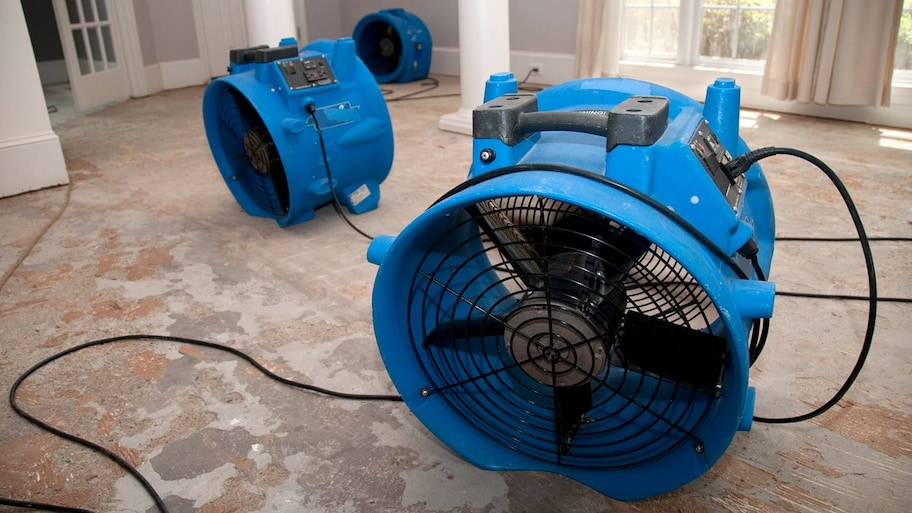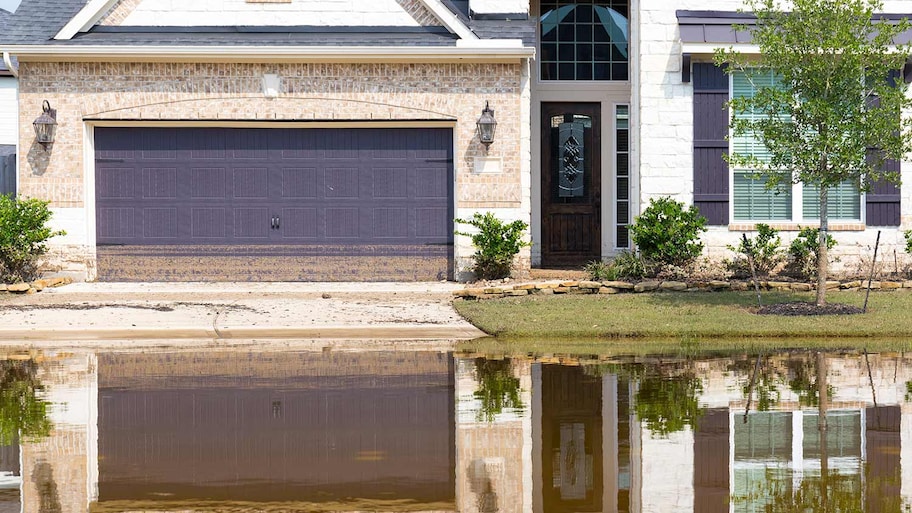Water Damage Restoration Checklist: 8 Steps to Save Your Home After a Flood
Inspect the damage, extract the water, and protect your home


Highlights
Signs of water damage include peeling paint, discoloration on walls and floors, soft or bumpy walls or flooring, moldy smells, and mold growth.
If you suspect mold to be an issue, do not stay in your home. Call a pro and leave immediately.
Get in contact with your insurance company as soon as possible to document the damages.
Whether it’s a burst pipe or a hurricane, flooding from any source can devastate homeowners and their property. Even more stressful is the fact that water remediation needs to start immediately to prevent dangerous mold growth and permanent damage.
To start remediation as soon as possible, follow this water damage restoration checklist and be sure to hire a local water damage restoration professional to avoid long-term water damage. Note: It's always safer to hire a pro to inspect and repair flooding damage for you.
Signs of Water Damage
If your home has any type of water damage after a flood or burst pipe, it's often easy to spot.
One of the most obvious signs of water damage is discoloration on your walls or floors. Water typically creates brown or tan marks on the wall, particularly if the paint color is light. Another telltale sign of water damage is peeling paint or wallpaper.
Water damage can also affect the texture of walls and flooring. If the walls feel soft or bumpy, they are probably damaged by water. Warped or uneven walls or floors usually also have water damage.
If your home has water damage due to a leaking or burst pipe, you can usually hear the problem, too. Listen closely for the sounds of rushing or dripping water. Take a look at your water bill. If there's a leak, you'll see an increase in your bill.
Sometimes, you may be able to smell water damage, even if you can't see it. Mold and mildew love moisture and will grow in wet areas. They often produce a musty odor. You may be able to see mold growth, which can look like dark fuzz, on the walls or floor.
If you see mold or have a strong suspicion that there’s mold in your home, gather a few essentials and leave as soon as you can. Mold can cause many negative health effects, such as upper respiratory symptoms like wheezing and coughing, in addition to stronger effects for those who have a sensitivity to mold, according to the Centers for Disease Control.
1. Perform a Water Damage Inspection
Again, to be safe, you may want to hire a water damage restoration pro to inspect your home. Depending on the size of the flood, your home could be unstable and unsafe to conduct a water damage inspection yourself.
You may be able to determine how hazardous the situation is based on the water’s color, and the water damage restoration pro may ask you this before they arrive onsite. White water is typically not contaminated and may originate from a burst pipe or broken water heater. Gray or black water is more hazardous, with gray water often coming from dishwashers or washing machines and black water coming from contaminated sources like toilets, sewage, or flood waters from a natural disaster. Do not attempt to clean up hazardous water yourself.
Determine the stability of the structure and look for any buckling or caving before and after entering it. If you see this, do not enter; leave immediately.
Before entering the property, you must wear personal protective equipment (PPE), such as safety goggles, rubber boots, a hard hat, a face mask, and gloves.
Find the source of the flood and shut it off, if possible.
Turn off electricity and gas to the structure. If the breaker box is in a wet area, use a dry object, like a stick, to turn it off while standing in a dry area and wearing rubber boots. If you can't safely turn off the power from a dry area, do not attempt to do this yourself: It's time to call in a pro.
Identify the color of flood waters to get an idea of the contamination level.
Calculate the water damage based on the wetness of materials, like carpets, textiles, or insulation.
2. Call Your Insurance Companies
For your home, you’ll need to contact your homeowners or renters insurance company; for vehicle damage, contact your car insurance company. You’ll also need to document the damage for your insurance companies, so be sure to take photos.
Here’s what you will want to ask your insurance companies:
Discuss what your policy covers for floods.
Ask if the policy covers living expenses if you need to relocate during flood remediation.
For vehicles, tell the insurance company where the claims adjuster will find the vehicle.
Ask if your policy covers car rentals.
3. Gather Your Essential Documents
There are several important documents you need to secure if you don’t have them on you already. Some of these items will help for insurance purposes, and others are just important documents to have on you. Remember only to gather the documents if you can do so safely while wearing your protective gear.
Gather the following documents as part of your flood remediation checklist:
Mortgage or deed and proof of mortgage payments
Drivers’ licenses
Social Security cards and birth certificates
Credit and debit cards
List of prescribed medications
List of bank account numbers
4. Start Extracting Water and Cleaning Up
With the water damage assessed and documented, it’s time to start cleaning up. It’s important to extract any standing water and clean the area as soon as possible. The longer the water stands, the more damage it can cause, and it gives mold more time to grow, posing long-term health risks to your family.
However, you need to do so safely, and that could mean doing so in stages. Again, with major flooding, hiring a pro is always your best bet.
Stary by extracting standing water with industrial wet/dry vacuums, pumps, or buckets.
Note: If the flooding is severe, you'll have to do this in stages so that you don't risk the basement caving in. The Federal Emergency Management Agency (FEMA) recommends that you mark the water's height on the wall and start by removing 1 foot at a time. Wait overnight, and then remove another foot, waiting another 24 hours. If the water continues to stay at that level, and everything seems stable, you can up the amount to around 2 to 3 feet per 24 hours until the water is gone.
Then, you can move on to the next steps:
Remove furniture, rugs, carpeting, and other wet items and place them in a shady but dry place.
Use a shovel to clear away any mud or other dirt that flowed into the home.
Open up wet walls and take out any wet insulation to prevent mold growth and decay.
Pull up floors to inspect for water damage and prepare for the drying process.
5. Dry the Area

Once the standing water is gone, you need to start drying out the home immediately. Ideally, extraction and drying should start within 48 hours after the flooding stops. Be patient because it may take several weeks for the house to fully dry after a flood.
Set up dehumidifiers around the home to pull moisture from the air as the floors and walls dry out.
Put industrial-size fans throughout the house to speed up the drying process.
Run the air conditioning.
If the weather forecast is sunny and dry, you can also open doors and windows to facilitate drying out the home.
6. Sanitize to Prevent Mold
Even after removing wet furniture, carpets, floors, and subfloors, your home is still at risk of harboring mold after a flood. You’ll need to sanitize the affected areas to stop mold and fungi from spreading.
Make a disinfectant by combining about 1 cup of bleach with 1 gallon of water.
Use the disinfectant on walls, floors, and other hard surfaces.
Inspect textiles and furniture for water damage to determine what can be cleaned and sanitized.
Hire a professional carpet cleaner to properly clean and disinfect salvageable textiles.
Consider hiring a local furniture repair specialist to clean any affected furniture.
Toss waterlogged items that are too damaged to sanitize and repair.
7. Clean and Dry Personal Belongings
After a flood, the primary focus is typically on large items, like furniture and the building itself. But don’t forget that everything in your home, including personal belongings, will need attention.
During water damage cleanup, pay attention to the following:
Soft items like mattresses and stuffed animals: You most likely can't save water-damaged upholstered items, mattresses, or stuffed toys. Bag them up and move them outside for the adjuster to review.
Photographs and art: Let artwork and photographs dry, then store them away until you can get help from a restoration professional.
Clothing and textiles: Store these items outdoors until a restoration professional can evaluate whether or not you can salvage them.
Electronics: Place all electronics in a dry place, unplugged. Do not attempt to use them. These items are sometimes salvageable with help from restoration professionals.
Hard, durable items: Dishware, utensils, and decorative objects can usually be deep cleaned and disinfected after a flood.
8. Start Home Repairs

It may take weeks, but you should wait until your home is fully dry before making any repairs.
Replace subfloors that show signs of damage after drying, like buckling or warping.
Restore or replace hardwood, tile, or carpet floors.
Replace insulation before repairing or replacing drywall.
DIY vs. Hiring a Pro for Water Damage Restoration
If your home has suffered from any level of water damage due to a weather event like flooding or a hurricane, or because of a leaky roof or burst pipe, you may be tempted to try to handle the cleanup yourself. But improperly cleaning up after serious water damage can leave your home—and your family—at risk, whether it’s from a weakened structure or mold growth.
We always recommend hiring a professional water damage remediation company and a local mold removal company at the first signs of water damage. If the water damage is due to a severe weather incident, these are likely the only contractors you will need to hire. But if there’s water damage because of a leaky roof, burst pipe, or improperly installed window or door, you’ll need to call in other pros, such as a local plumber or roofer, to help prevent water damage in the future.
The cost of water damage restoration may seem steep, especially if there’s extensive damage. However, it’s possible this service will be covered by your homeowners insurance policy. As soon as you notice the water damage, call up your agent to start the process of hiring a pro and getting reimbursed for the service.
Frequently Asked Questions
Any item that can hold on to moisture and encourage mold growth should be discarded and replaced following water damage. Upholstered items, such as armchairs and couches, and soft items, such as mattresses, usually must be thrown away once they've taken on a lot of water. Soft furniture is difficult to dry out, creating an inviting environment for mold.
You may also need to replace hardwood furniture following water damage if you're unable to fully dry it out. If you have appliances and electronics that have been fully submerged in water, particularly sewage, you'll need to replace those, too.
Mold grows quickly. It typically begins to grow on drywall about 24 hours after exposure to moisture or humidity. Drywall is a porous material, which makes it particularly hospitable to mold growth.
While mold growth begins after just a day or so, it can take a few weeks before the evidence becomes visible. Mold spores will typically appear on the drywall surface within three weeks of growth starting.
Water restoration should be left to the professionals. When choosing a water damage remediation company, look for one that is insured, licensed, and bonded. It's also a good idea to ask for references and read reviews online.
Find out about the company's experience and ask for a timeline for the repairs and restoration.
